动词不定式详解
非谓语之动词不定式用法详解

动词不定式的用法二、动词不定式充当的句子成分不定式具有名词、动词、形容词和副词的特性,在句中可以作主语、宾语、表语、定语、状语和宾语补足语。
(一)、作主语:1、不定式作主语多表示具体的、一次性的动作;动名词作主语多表示经常性的、习惯性的动作。
如:To swim today is a good idea Eating too much is bad for your health.2、不定式作主语时,常可以用it 作形式主语,而将真正的不定式主语后置。
但要熟记以下使用动名词作主语的句型:常用动名词作主语的句型有:It is/was +There is/was +更糟糕的)注意:There is no need for sb to do sth.2. 一般情况下,不定式作主语,谓语动词一般用单数形式。
如:To see is to believe.3. 当主语为不定式时,表语也用不定式来表示一致性。
如:To see is to believe.(二)、作宾语1、不定式作宾语通常表示具体的、一次性的动作。
如:Tom likes playing football, but he likes to play basketball today.但需要牢记以下的动词只使用v-ing 为宾语:avoid, miss, delay / postpone, suggest / advise, finish, practice, enjoy/appreciate, imagine, resist, admit, deny, envy, escape / envy, risk, pardon / excuse, keep / keep on, stand, mind;有些动词后面只能接不定式作宾语,如:decide/determine, learn, want, expect/hope/wish, manage, refuse, care, pretend, offer, promise, choose, plan, agree, ask/beg, help, wait, happen, afford, fail, threaten;有些动词短语后面也只能接动名词作宾语,如:lead to, get down to, look forward to, pay attention to, stick to,be addicted to, adjust/adapt to, devote to,object to,get to/be used to(习惯于),prefer…to…, can't stand(忍不住),give up,insist on,keep(on),put off,be worth,be/keep busy,have difficulty/trouble/problem(in),feel/look/seem like,set about,depend on,prevent sb. from,succeed in, thank you for, apologize for;有些动词后面既可以接不定式作宾语,又可以接动名词作宾语,如:continue,begin,start,prefer,like,love,hate,forget,go on,mean,regret,remember,stop,try,need, require, want 等。
动词不定式用法详解
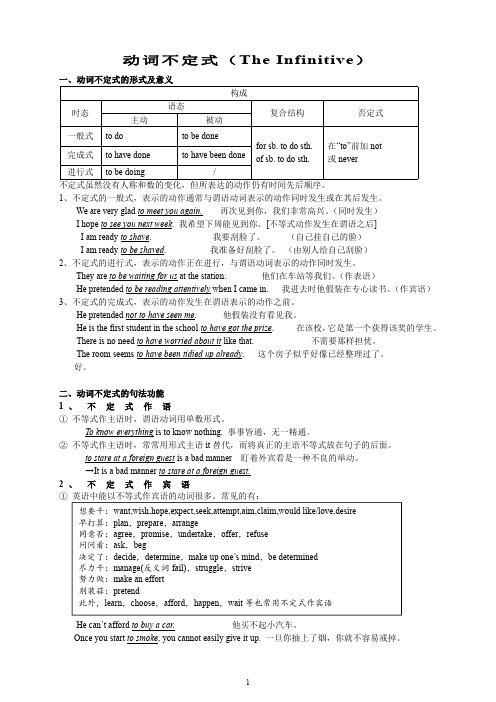
动词不定式(The Infinitive )一、动词不定式的形式及意义构成时态语态复合结构否定式主动被动一般式to do to be done for sb.to do sth.of sb.to do sth.在“to”前加not 或never完成式to have done to have been done 进行式to be doing /不定式虽然没有人称和数的变化,但所表达的动作仍有时间先后顺序。
1、不定式的一般式,表示的动作通常与谓语动词表示的动作同时发生或在其后发生。
We are very glad to meet you again.再次见到你,我们非常高兴。
(同时发生)I hope to see you next week .我希望下周能见到你。
[不等式动作发生在谓语之后]I am ready to shave .我要刮脸了。
(自己挂自己的脸)I am ready to be shaved .我准备好刮脸了。
(由别人给自己刮脸)2、不定式的进行式,表示的动作正在进行,与谓语动词表示的动作同时发生。
They are to be waiting for us at the station.他们在车站等我们。
(作表语)He pretended to be reading attentively when I came in.我进去时他假装在专心读书。
(作宾语)3、不定式的完成式,表示的动作发生在谓语表示的动作之前。
He pretended not to have seen me .他假装没有看见我。
He is the first student in the school to have got the prize .在该校,它是第一个获得该奖的学生。
There is no need to have worried about it like that.不需要那样担忧。
The room seems to have been tidied up already .这个房子似乎好像已经整理过了。
详解动词不定式的五种

详解动词不定式的五种“式”不定式根据其发生的时间不同以及所处的状语的不同,可以有一般式、完成式、进行式、完成进行式,同时根据它与逻辑主语的关系的不同,可以有主动式和被动式。
如下表:一、不定式一般式的用法1. 表示未发生的动作即表示发生在谓语动作之后的动作。
如:I expect him to arrive tomorr ow. 我预计他明天到达。
I hope to catchan earlytrain.我希望赶上早班火车。
The doctor advise d me to take a comple te rest. 医生建议我完全休息。
2. 表示同时发生的动作即表示与谓语动作同时发生或略先于谓语动作的动作。
如:Who heardhim say that? 是谁听到他这样说的?(say与he ard几乎同时发生) I‟msorryto hear that. 听到这事我很难过。
(to hear 略先于amsorry)3. 表示一般情况即看不出动作的先后关系,而是表示一种情况或现象。
如:Washin g the car seemsto be your main hobby.擦洗汽车似乎是你的主要爱好。
None of her many lovers seemed to want to marryher. 在她的许多情人中似乎没有一个愿意娶她的。
二、不定式进行式的用法1. 表示同时进行即表示与谓语动作同时发生且正在进行的动作。
如:He seemsto be follow ing us. 他似乎在跟着我们。
He preten ded to be lookin g for a book. 他假装在找书。
I happen ed to be lookin g out of the window when they arrive d. 他们到达时我碰巧正向窗外望去。
详解动词不定式的五种

详解动词不定式的五种“式”不定式根据其发生的时间不同以及所处的状语的不同,可以有一般式、完成式、进行式、完成进行式,同时根据它与逻辑主语的关系的不同,可以有主动式和被动式。
如下表:一、不定式一般式的用法1. 表示未发生的动作即表示发生在谓语动作之后的动作。
如:I expect him to arrive tomorrow. 我预计他明天到达。
I hope to catch an early train. 我希望赶上早班火车。
The doctor advised me to take a complete rest. 医生建议我完全休息。
2. 表示同时发生的动作即表示与谓语动作同时发生或略先于谓语动作的动作。
如:Who heard him say that? 是谁听到他这样说的?(say与heard几乎同时发生)I’m sorry to hear that. 听到这事我很难过。
(to hear 略先于am sorry)3. 表示一般情况即看不出动作的先后关系,而是表示一种情况或现象。
如:Washing the car seems to be your main hobby. 擦洗汽车似乎是你的主要爱好。
None of her many lovers seemed to want to marry her. 在她的许多情人中似乎没有一个愿意娶她的。
二、不定式进行式的用法1. 表示同时进行即表示与谓语动作同时发生且正在进行的动作。
如:He seems to be following us. 他似乎在跟着我们。
He pretended to be looking for a book. 他假装在找书。
I happened to be looking out of the window when they arrived. 他们到达时我碰巧正向窗外望去。
2. 表示将来正如可用进行时态表示将来意义一样,不定式的进行式有时也可表示将来。
动词不定式详解课件
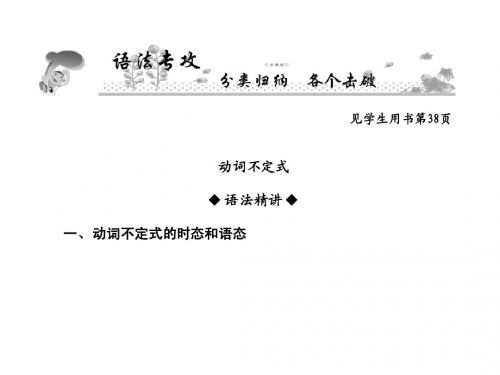
功能
典句例示
要点点击 常用it作形式主语, 常用 作形式主语,谓语动 作形式主语 词用单数。 词用单数。 表示主语的“职业, 表示主语的“职业,职责和 性质” 性质”等。 不定式作宾语时, 不定式作宾语时,常跟在下
主语 It's very hard to learn an art.
表语 My goal is to be a scientist.
2.不定式所修饰的名词或代词和不定式逻辑上构成主谓关 . 系时,不定式往往用主动形式。 系时,不定式往往用主动形式。 Do you have a knife to cut the birthday cake? (A knife cuts the birthday cake.) ) 3.不定式作表语形容词的状语,和句子主语构成逻辑上的 .不定式作表语形容词的状语, 动宾关系时不定式多用主动形式。 动宾关系时不定式多用主动形式。 This book is difficult to understand.
【解析】 分析句子结构空格后是目的状语,所以用动词不定 解析】 分析句子结构空格后是目的状语, 句意:父亲节即将来临, 式。句意:父亲节即将来临,我已经从银行取了些钱要给父亲买礼 物。 【答案】 B 答案】
2.(2010·江西高考)There were many talented actors out .(2010·江西高考) 江西高考 there just waiting ________. A.to discover . C.discovered . B.to be discovered . D.being discovered .
不定式的否定形式的构成: 【温馨提示】 1.不定式的否定形式的构成: 温馨提示】 不定式的否定形式的构成 动词不定式的否定形式是在不定式的符号“ 前直接加上 动词不定式的否定形式是在不定式的符号“to”前直接加上 not,有时为了强调也可以用否定词 ,有时为了强调也可以用否定词never来否定。 来否定。 来否定 It's wrong of you not to go to school on time. 2.在“be+性质形容词十不定式”结构中,不定式用主动 . +性质形容词十不定式”结构中, 形式表示被动含义。常见的形容词有: 形式表示被动含义。常见的形容词有:easy,hard,difficult, , , , interesting,heavy,pleasant,good,fit,comfortable,safe, , , , , , , , dangerous,impossible等。 , 等
动词不定式详解

非谓语动词之动词不定式(一)动词不定式的一般形式1.不定式的时态:分为一般体(to do),进行体(to be doing),完成体(to have done),完成进行体(to have been doing)。
2.不定式的否定:不定式的否定形式通常是在不定式之前加not、never等否定词。
3.不定式的被动:通常是由to be done和to have been done构成。
(二)不带to的动词不定式1.在情态动词之后:例如must、can、should、need、dare(当need、dare作为主动词时,后面跟带to的不定式)。
特别地:ought to2.在半助动词之后:类似于be sure to、have got to、had better、happen to等。
3.在情态成语之后:a)would rather/would sooner/would just as soon(宁愿、宁可);后跟…than/as…的句子时,译为宁愿…也不愿…,从句中也用不带to的动词不定式。
b)may/might (just) as well;译为不妨,还是…为好c)can’t but/can’t help but;译为必须,不得不d)rather than/sooner than(宁可…也不…),其置于句首时,后跟不带to的动词不定式;放在句中其他位置时,to可加可不加。
4.在“主动词+主动词”固定搭配的第一主动词之后:第二主动词就是不带to的动词不定式,这类搭配常有:make believe(假装);make do with/on(依靠...维持;凑合);let drop/fall(有意无意说出);hear tell of(据说,听说);let slip(无意中泄露,错过)5.在let、make、have等“使役动词+宾语”结构之后:宾语补足语用不加to的动词不定式。
当使役变为被动态时,需要加上带to的动词不定式。
动词不定式知识点详解(初中英语专项复习)8
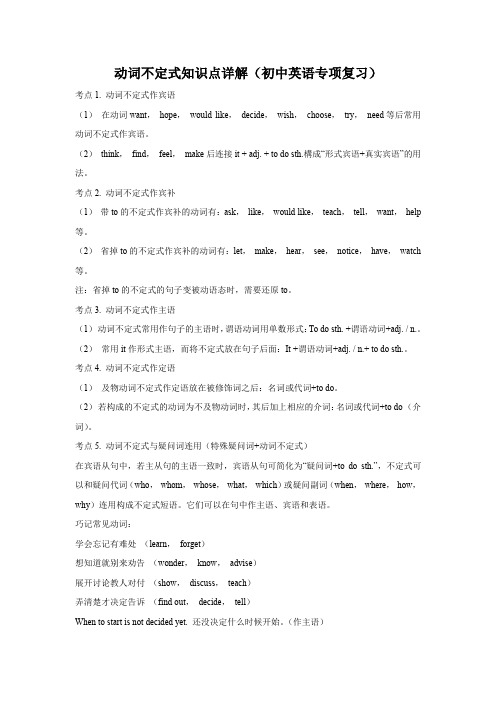
动词不定式知识点详解(初中英语专项复习)考点1. 动词不定式作宾语(1)在动词want,hope,would like,decide,wish,choose,try,need等后常用动词不定式作宾语。
(2)think,find,feel,make后连接it + adj. + to do sth.構成“形式宾语+真实宾语”的用法。
考点2. 动词不定式作宾补(1)带to的不定式作宾补的动词有:ask,like,would like,teach,tell,want,help 等。
(2)省掉to的不定式作宾补的动词有:let,make,hear,see,notice,have,watch 等。
注:省掉to的不定式的句子变被动语态时,需要还原to。
考点3. 动词不定式作主语(1)动词不定式常用作句子的主语时,谓语动词用单数形式:To do sth. +谓语动词+adj. / n.。
(2)常用it作形式主语,而将不定式放在句子后面:It +谓语动词+adj. / n.+ to do sth.。
考点4. 动词不定式作定语(1)及物动词不定式作定语放在被修饰词之后:名词或代词+to do。
(2)若构成的不定式的动词为不及物动词时,其后加上相应的介词:名词或代词+to do (介词)。
考点5. 动词不定式与疑问词连用(特殊疑问词+动词不定式)在宾语从句中,若主从句的主语一致时,宾语从句可简化为“疑问词+to do sth.”,不定式可以和疑问代词(who,whom,whose,what,which)或疑问副词(when,where,how,why)连用构成不定式短语。
它们可以在句中作主语、宾语和表语。
巧记常见动词:学会忘记有难处(learn,forget)想知道就别来劝告(wonder,know,advise)展开讨论教人对付(show,discuss,teach)弄清楚才决定告诉(find out,decide,tell)When to start is not decided yet. 还没决定什么时候开始。
动词不定式(九年级英语语法详解)

He promised not to tell anyone about it.
warn, tell, allow, help, ask, force等
(4). 宾补
The teacher told me to clean the blackboard
I expect you to give me some help.
A.reading
B. to read
C. to be reading D. being read
1. To be here at Christmas time is my dream. →It is my dream to be
here at Christmas time. 2. To go abroad is his dream.
→ It is his dream to go abroad. 3. To say is easy, to do is difficult.
is when to start.
表语
He taught us how to use the computer. 宾补 注意:
•在与why连用时,只用于why或why not开头 的简短疑问句中,后面紧跟的动词不定式不带to。
• Why not have a rest
•固定句型:
1. had better/had best + (not) do sth. 最好(不)做某事
7. …would rather do A than (do) B
Hale Waihona Puke 8. …would rather + 句子(过去式)
9.
(虚拟语气) 要
易错点08 非谓语动词之动词不定式(解析版)
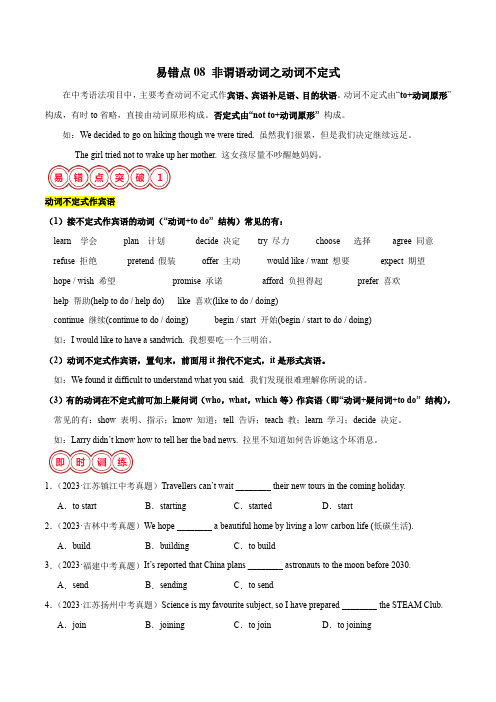
易错点08非谓语动词之动词不定式在中考语法项目中,主要考查动词不定式作宾语、宾语补足语、目的状语。
动词不定式由“to+动词原形” 构成,有时to省略,直接由动词原形构成。
否定式由“not to+动词原形”构成。
如:We decided to go on hiking though we were tired. 虽然我们很累,但是我们决定继续远足。
The girl tried not to wake up her mother. 这女孩尽量不吵醒她妈妈。
动词不定式作宾语(1)接不定式作宾语的动词(“动词+to do” 结构)常见的有:learn 学会plan 计划decide 决定try 尽力choose 选择agree 同意refuse 拒绝pretend 假装offer 主动would like / want 想要expect 期望hope / wish 希望promise 承诺afford 负担得起prefer 喜欢help 帮助(help to do / help do) like 喜欢(like to do / doing)continue 继续(continue to do / doing) begin / start 开始(begin / start to do / doing)如:I would like to have a sandwich. 我想要吃一个三明治。
(2)动词不定式作宾语,置句末,前面用it指代不定式,it是形式宾语。
如:We found it difficult to understand what you said. 我们发现很难理解你所说的话。
(3)有的动词在不定式前可加上疑问词(who,what,which等)作宾语(即“动词+疑问词+to do” 结构),常见的有:show 表明、指示;know 知道;tell 告诉;teach 教;learn 学习;decide 决定。
动词不定式

• 二、功能如同名形副 不定式在句子中相当于名词、形容词、副词。 1、不定式可以作主语、宾语和表语,相当于一个名 词,如: To see is to believe. 眼见为实。 注意:在系表结构中,当主语是表示目的的名词(如 purpose、aim、objective、goal、intention等)时,表语要 用不定式,如: Our goal is to satisfy customers' needs. 我们的目标 是满足顾客的需要。 2、不定式可以作定语和补语,相当于一个形容词, 如: John is the first disabled person to sail around the world. 约翰是第一个环球航行的残疾人。 3、不定式可以作状语,相当于一个副词。不定式常 作目的状语,此时它也常用于一些固定搭配(如in order to、 so as to等),如: Many people open blogs so as to exchange their own views and thoughts with others. 许多人创建博客, 以便和他人交流自己的观点和看法。
• 动词不定式 • 动词不定式在中学英语中应用非常广泛,一方 面在句中可起名词、形容词或副词的作用,同 时也可在句中作主语、宾语、定语、状语和宾 语补足语。动词不定式的形式一般是to +动词 原形,但to有时要省去。而动词不定式在具体 运用时用不用to,取决于谓语动词的用法。现 就以下几方面介绍如下。
•
地点状语从句 (adverbial clause of place) 地点状语 从句一般由连接副词where, wherever等引导,已经形成 了固定的句型.
• Where+地点从句,( +地点从句,(there)+主句。 )+主句 【注意】此 ,( )+主句。 句型通常译成“哪里……哪里就……”;主句在从句后面 时,there可用可不用;如果主句在从句的前面时,一般 都不用there。例如: Where there is no rain, farming is difficult or impossible.在没有雨水的地方,耕作 是困难的,或根本不可能的。 They were good persons. Where they went, there they were warmly welcomed. 他们都是好人。因此他们走到哪里都受到热烈 欢迎。 You should have put the book where you found it. 你本来应该把书放回原来的地方。 Where the Communist Party of China goes, there the people are liberated.哪里有了中国共产党,哪里人民得解放。
动词不定式用法讲解
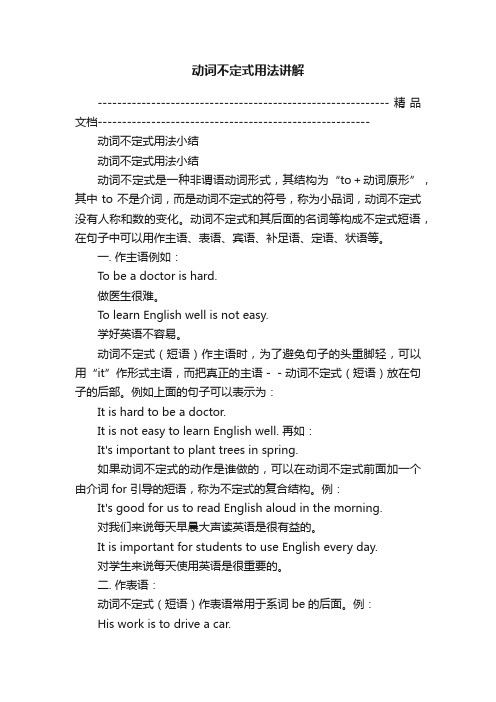
动词不定式用法讲解------------------------------------------------------------精品文档-------------------------------------------------------- 动词不定式用法小结动词不定式用法小结动词不定式是一种非谓语动词形式,其结构为“to+动词原形”,其中to不是介词,而是动词不定式的符号,称为小品词,动词不定式没有人称和数的变化。
动词不定式和其后面的名词等构成不定式短语,在句子中可以用作主语、表语、宾语、补足语、定语、状语等。
一. 作主语例如:To be a doctor is hard.做医生很难。
To learn English well is not easy.学好英语不容易。
动词不定式(短语)作主语时,为了避免句子的头重脚轻,可以用“it”作形式主语,而把真正的主语--动词不定式(短语)放在句子的后部。
例如上面的句子可以表示为:It is hard to be a doctor.It is not easy to learn English well. 再如:It's important to plant trees in spring.如果动词不定式的动作是谁做的,可以在动词不定式前面加一个由介词for 引导的短语,称为不定式的复合结构。
例:It's good for us to read English aloud in the morning.对我们来说每天早晨大声读英语是很有益的。
It is important for students to use English every day.对学生来说每天使用英语是很重要的。
二. 作表语:动词不定式(短语)作表语常用于系词be的后面。
例:His work is to drive a car.他的工作是开车。
My job is to feed animals.我的工作是饲养动物。
高考高中英语核心语法详解 动词不定式

高考高中英语核心语法详解动词不定式一、基础知识1.构成方式:动词原形前加to 构成,即 to + v;同时继承原形动词本身的所有用法;传统语法上也叫非谓语动词。
常见形式:以do为例一般时:主动态 to do(原形) ;被动态 to be + done (过去分词);进行时:主动态 to be + doing(现在分词);无被动态;完成时:主动态 to have +done (过去分词);被动态 to have been+ done过去分词);完成进行时:主动态 to have been +doing (现在分词);无被动态;否定形式: not/never to + v;2.内在含义:未做之事,具有不确定的语气;要去做某事,或是未来的一种状态。
3. 动词不定式to的省略(1)使役动词,指的是像 let, make, have, get…之类的动词,共同点是都带有强迫意味,没有不确定的语气。
Now let the boy go.现在让男孩走。
(2) 感官动词,指的是像 see, hear, feel, smell…之类的动词,表示看到、听到、感觉到后面那件事情应该确实发生了,才能够看到或听到。
不适合采用具有不确定意味的不定词.Did you feel the desk shake? 你感到课桌摇晃了吗?4. 表示不定式to与介词to的区别不定式to,介词也拼成to,有时会造成混淆。
不定式的to带有不确定语气,后面要接原形动词;介词 to 类似 toward,表示「对、向」,后面要接名词(包括动名词)。
(1)I used to walk 3 km to school when I was a kid. (我小时候经常走三公里上学。
)(表示过去的习惯,即要去做什么)(2)I am looking forward to spending the weekend in the mountains.(我盼望到山上去过周末。
动词不定式用法详细讲解

动词不定式用法详细讲解1、构成及特征动词不定式(infinitive)是动词的一种非限定形式,即非谓语动词形式,它有两种形式:一种是“to + 动词原形”构成(to- infinitive);另一种是不带to的不定式,即动词原形(bare- infinitive)。
所有行为动词都有不定式形式,其否定式是在不定式前加not。
动词不定式(或不定式短语)没有人称和数的变化,在句子中不能作谓语。
动词不定式仍保留有动词的特点:(1)可以有时式和语态的变化,也可以有自己的宾语或状语,它们一起构成了不定式短语。
He tried to work out the problem in five minutes.他试图在五分钟之内算出这道题。
(带宾语和状语)The factory to be built here next year is a car factory.明年在这里建的工厂是一家汽车制造厂。
(有语态的变化)(2)动词不定式还具有名词、形容词和副词的特征,在句中可以作主语、宾语、表语、补语、定语、状语等成分。
He wants to study English.他想学英语。
(to study English在句中作want的宾语,而to study又有自己的宾语English, to study和English一起构成了不定式短语。
)Never to offend anyone is his principle.不得罪人是他的原则。
(不定式作主语)注意:不定式在许多场合具有情态意义。
作主语时,相当于一个带有情态动词的主语从句;作宾语时,相当于一个带有情态动词的宾语从句;作定语时,相当于一个带有情态动词的定语从句;作目的状语时,相当于so that 或in order that引导的目的状语从句。
It is right for her to say so.(= It is right that she should say so.)她这样说是对的。
中考英语总复习之动词不定式-详解与练习
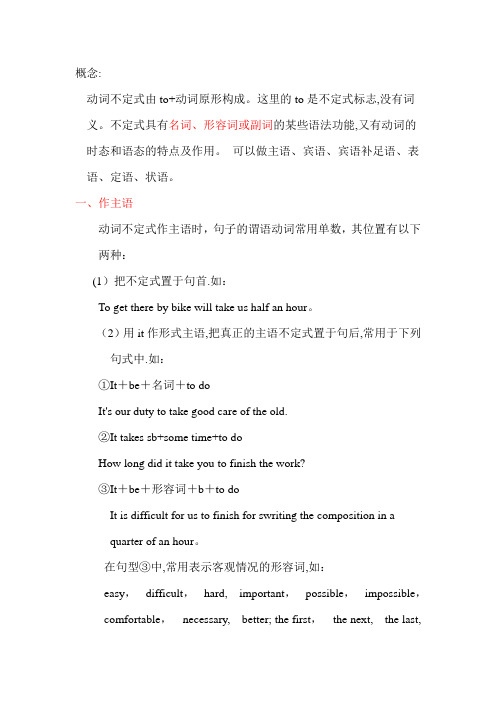
概念:动词不定式由to+动词原形构成。
这里的to是不定式标志,没有词义。
不定式具有名词、形容词或副词的某些语法功能,又有动词的时态和语态的特点及作用。
可以做主语、宾语、宾语补足语、表语、定语、状语。
一、作主语动词不定式作主语时,句子的谓语动词常用单数,其位置有以下两种:(1)把不定式置于句首.如:To get there by bike will take us half an hour。
(2)用it作形式主语,把真正的主语不定式置于句后,常用于下列句式中.如:①It+be+名词+to doIt's our duty to take good care of the old.②It takes sb+some time+to doHow long did it take you to finish the work?③It+be+形容词+b+to doIt is difficult for us to finish for swriting the composition in aquarter of an hour。
在句型③中,常用表示客观情况的形容词,如:easy,difficult,hard,important,possible,impossible,comfortable,necessary,better; the first,the next,the last,the best,too much,too little,not enough④It+be+形容词+of sb+to doIt is stupid of you to write down everything the teacher says.在句型④中,常用careless,clever,good,foolish,honest,kind,lazy,nice,right,silly,stupid,wise rude,clever,foolish,thoughtful, thoughtless(欠考虑的;不考虑的),brave,considerate(考虑周到的),selfish(自私的)等表示赞扬或批评的词。
初二表目的的动词不定式详解

know, wonder, decide, 注意:remember, learn, tell,
show, teach等
+疑问词+to do
5. 作表语
用于be 动词后作表语 Eg. My wish is to become a college student.
The most important thing is to be honest.
6. 作状语
目的状语 to/in order to/ so as to He got up early to catch the early bus. =He got up early in order to catch the early bus. =He got up early so as to catch the early bus. = To catch the early bus he got up early. = In order to catch the early bus he got up early.
否定式的用法
表否定目的 not 在to 前
• in order not to do so as not to do • 注意 一般不用 not to do(表结果)
• in order not to be eaten by the panda, • Miss Bamboo runs quickly
2. To teach such a naughty boy is not easy. =
3. To give me the wrong number is careless of you. =
初中英语语法:动词不定式的10大考点详解

下面以近几年全国局部省市的中考英语真题为例,对不定式的难点以及它在中考英语中的考查点,作一简要的总结和分析,供同学们学习时参考。
动词不定式作主语
1.It's our duty _________ the room every day.
初中英语语法:动词不定式的10大考点详解
收录于话题
动词不定式是初中英语的语法重点之一,也是每年中考英语真题的考点之一。
它是动词的一种非谓语形式,没有人称和数的变化,不能单独作句子的谓语。其构成形式为"to+动词原形",to为动词不定式的符号,本身无意义。
动词不定式具有两大特点:
1.具有动词的特点,因此,后面可以跟表语、宾语或状语,构成动词不定式短语。
A.to feel B.feels C.feeling D.feel (X省)
3.Your father is sleeping.You'd better ______.
A.not wake up him B.not to wake up him
C.not wake him up D.not to wake him up (X省)
The ice on the lake wasn't ______ enough ______ people ______ ______ ______.(X省)
Keys:6.is, too, small, for 7.thick, for, to, skate, on
【解析】在上述"too +形容词/副词(for X)to do…"(太……而不能……)和"enough (for X) to do…"(足以、足够……做……)结构中,不定式作结果状语。
中考动词不定式详解
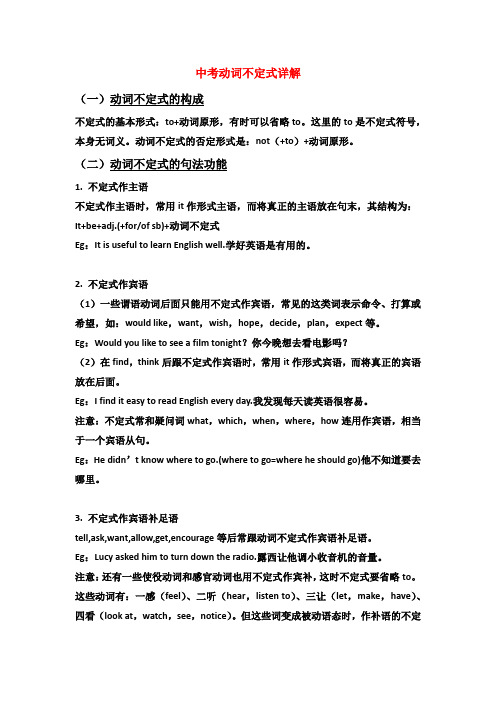
中考动词不定式详解(一)动词不定式的构成不定式的基本形式:to+动词原形,有时可以省略to。
这里的to是不定式符号,本身无词义。
动词不定式的否定形式是:not(+to)+动词原形。
(二)动词不定式的句法功能1.不定式作主语不定式作主语时,常用it作形式主语,而将真正的主语放在句末,其结构为:It+be+adj.(+for/of sb)+动词不定式Eg:It is useful to learn English well.学好英语是有用的。
2.不定式作宾语(1)一些谓语动词后面只能用不定式作宾语,常见的这类词表示命令、打算或希望,如:would like,want,wish,hope,decide,plan,expect等。
Eg:Would you like to see a film tonight?你今晚想去看电影吗?(2)在find,think后跟不定式作宾语时,常用it作形式宾语,而将真正的宾语放在后面。
Eg:I find it easy to read English every day.我发现每天读英语很容易。
注意:不定式常和疑问词what,which,when,where,how连用作宾语,相当于一个宾语从句。
Eg:He didn’t know where to go.(where to go=where he should go)他不知道要去哪里。
3.不定式作宾语补足语tell,ask,want,allow,get,encourage等后常跟动词不定式作宾语补足语。
Eg:Lucy asked him to turn down the radio.露西让他调小收音机的音量。
注意:还有一些使役动词和感官动词也用不定式作宾补,这时不定式要省略to。
这些动词有:一感(feel)、二听(hear,listen to)、三让(let,make,have)、四看(look at,watch,see,notice)。
高三英语动词不定式详解

注②:为了强调表示目的的不定式结构t 时,通常可以在不定式符号 to 之前加上 in order 或
so as,如: He came here in order to see Charlie. He shouted and waved so as to be noticed. He went early in order not to miss the train. I turned the radio down so as not to disturb him. 注③:表示目的的不定式可以置于句首,这也是区别于其他功能的 标志之一 。但是,置于句首表示目的的不定式之前可以加上 in
动词不定式
一、不定式结构作主语
To see one time is better than to hear a hundred times. To persevere means victory!
注①:在很多情况下,特别是在口语中,常采用先行it代替主语, 而把不定式后置:
It’s a great pleasure to be here.
It is not an easy thing to master a language. 注②:这种后置不定式的结构也适用于某些谓语动词不是系动词 的句子,如: It took us five hours to get there. It made us very angry to hear him talk like that.
三、不定式结构作动词宾语 1.“动词 + 带 to 的不定式结构”。这类动词常见的有:afford, agree, arrange, ask, choose, decide, demand, desire, expect, hope, learn, manage, offer, pretend, promise, refuse, want, wish, like, hate, prefer, continue, try, start, forget, mean, intend, begin, 等,例如: I’ve arranged to meet him at ten o’clock. I didn’t expect to find you here. 2.“动词 + 疑问词 + 带 to 的不定式结构”。(这种不定式结构接 近一个名词从句)。这类动词常见的有:tell, advise, show, teach, find out, decide, discuss, learn, forget, inquire, know, explain, remember, see, understand, wonder 等。 疑问词(也称连接代/副词)有:what, where, who(m), when, how, whether, which(why 除外),如: I don’t know what to do / where to go / who(m) to ask / when to stop / how to get there. I haven’t decided whether to sell it or not. We must find out what to do next / where to put it.
- 1、下载文档前请自行甄别文档内容的完整性,平台不提供额外的编辑、内容补充、找答案等附加服务。
- 2、"仅部分预览"的文档,不可在线预览部分如存在完整性等问题,可反馈申请退款(可完整预览的文档不适用该条件!)。
- 3、如文档侵犯您的权益,请联系客服反馈,我们会尽快为您处理(人工客服工作时间:9:00-18:30)。
Unit 7 动词不定式(一)
1、定义:动词不定式是非谓语动词的一种,无人称和数的变化在句中不能作谓语。
构
成: to +动词原形
2、用法:动词不定式具有名词、形容词和副词的特征,因此在句中可以做主语、表语、
宾语、宾语补足语,定语和状语。
本单元我们初步学习不定式宾语、宾语补足语、状语。
□1做宾语。
后面能接不定式做宾语的动词有:agree ,ask ,decide ,forget ,hope ,learn ,want ,wish ,would like ,try等。
We hope to get there before 7.
They began to read and write.
练习 1。
○1I wish (be)a college student.
○2I learn (speak)Japanese .
○3They decide (begin) the experiment at once.
○4What do you want (be)when you grow up?
○5They began (speak) in English .
○6He wants (play)football this afternoon.
□2做宾语补足语。
后面能接不定式做宾补的动词有ask ,order ,tell ,teach ,want ,wish ,like等。
She wants me to give her a help .
My teacher told me to work hard .
练习 2。
○1I asked Lucy (speak) more loudly.
○2He told us (not worry)about him.
○3I like you (do)it this way.
○4Please ask John (turn)on the light .
□3用作状语。
此时修饰动词和形容词,表示行为、原因、结果和目的。
I’m sorry to hear that.(做原因状语)
The boy is not old enough to work in the fields .(做结果状语)
They went to get their TV back.(做目的状语)
练习 3。
○1He got up early (catch) the first bus.
○2I’m glad (meet) you.
○3He sat down (have) a rest.
○4They went there (visit) their teacher.
○5He woke up (find) everyone gone.
○6I am so sorry (hear) your mother is ill.
本单元介绍了动词不定式做宾语补足语的用法,但当不定式在感官动词或使役动词后坐宾语补足语时应省略to.这样的感官动词或使役动词在此归纳为“一感、二听、三让、四看、半帮助,最后‘一最’”
“一感”:feel 如:I felt someone open my door.
“二听”:listen to ,hear. 如:
Please listen to me sing the song again.
I heard someone come into my room.
“三让”:let ,make ,have 如:
You can’t let /make/have the boy stand in the sun.
“四看”:look at, see ,watch ,notice. 如:
He often looks at other people dance .
Did you see/notice a boy go into the school.
You must watch me carefully do everything .
“半帮助”: help , He often helps me (to)clean the room.
“最后一最好”:had better . Everyone had better know a little English .
但我们还要知道“feel ,hear ,see ,watch ,notice”还可以跟现在分词作宾语补足语。
如:
I saw him dancing. 我看到他正在跳舞。
(看到跳舞的一个片断)
I saw him dance. 我看到他跳舞了。
(看到跳舞的全过程)
I heard her singing. 我听见他正在唱歌。
(听到唱歌的一个片断)
I heard her sing. 我听到他唱歌了。
(听到唱歌的全过程)
Unit 15 动词不定式(三)
一、动词不定式做主语(形式主语it):
To study English well is easy. 学好英语时容易的。
为使句子的主语不显得过长,避免头重脚轻,常用it做形式主语,而不定式放在句尾,如上句可改写为:It is easy to study English well.此时it做了形式主语,而真正主语是to study English well.
再如:To play in the street is dangerous.=It is dangerous to play in the street.
练习 1 改写下列句子并翻译成汉语
○1To learn a foreign language is not easy.
○2To finish the book is impossible in two weeks.
○3It’s better to give than to receive.
○4It’s a great pleasure to talk with her.
○5To work hard brings success.
○6To do well is better than to say well.
○7To learn English well needs a great deal of practice.
二、动词不定式做宾语(形式宾语it):后面可接it做形式宾语的动词有think, make,
find, feel.如:
主语谓语形式宾语宾语补足语真正宾语
(我发现学好英语非常重要)
此句中宾语补足语(very important)用来说明真正宾语(to learn English well)的性质是非常重要的。
此时的宾语补足语只能由形容词来充当。
在如:
主语谓语形式宾语宾语补足语真正宾语
(我认为学好英语非常容易)
练习 2 分析下列句子成分划分主谓宾
○1Scientists think it necessary to search for evidence.
○2The spaceship makes it possible for man to travel in space.
○3Satellite makes it easy for people to see what is happening in distant countries. ○4I think it impossible for me to read all the materials in English in a few days. ○5My children find it exciting to watch television.。
